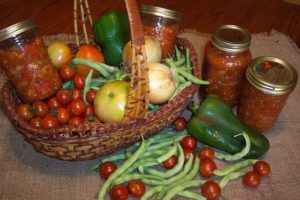Ohio farmers and gardeners harvest a cornucopia of tomatoes in late summer. Yes, they are a fruit from a horticultural perspective, but nutritionists would say they’re vegetables since they’re low in fructose but high in phytonutrients, vitamins A and C. A tomato a day, no matter what the form whether consumed fr esh, frozen, sauced, or canned might help keep the doctor away!
esh, frozen, sauced, or canned might help keep the doctor away!
How do tomatoes improve health?
- Lycopene acts as an antioxidant in the body and may reduce inflammation.
- High tomato intake is related to reduced risk of prostate cancer and possibly other cancers, as well as heart disease.
For best flavor and highest lycopene levels in fresh tomatoes, pick when ripe and red. They will continue to ripen at home if stored at room temperature.
- Lightly cooked and canned tomatoes are a good option for optimizing lycopene content. However, there is some loss of vitamins A and C. Vitamin C is better preserved when canned or cooking liquid is consumed.
- Eating tomatoes with a little oil can help your body absorb the lycopene.
- Drying causes significant losses in vitamin C and vitamin A.
Tomatoes and tomato products can be canned using a pressure canner or a boiling water bath. For high quality tomato products, a pressure canner is recommended over a water bath. Also, although most tomatoes are high acid, a few varieties are not. Therefore it is recommended that you add lemon juice, citric acid, or vinegar before canning. Since botulism can thrive in canned foods that are not processed correctly, it is not safe to can your tomatoes and tomato products using your own home recipes (including salsa). Rather use the latest Ball Blue Book or USDA recipes that have been tested for safety. These will be also be available on OSU Extension’s website at http://ohioline.osu.edu.
to can your tomatoes and tomato products using your own home recipes (including salsa). Rather use the latest Ball Blue Book or USDA recipes that have been tested for safety. These will be also be available on OSU Extension’s website at http://ohioline.osu.edu.
When freezing tomatoes, select firm, ripe tomatoes with deep red color. Wash thoroughly; sort and trim. For freezing raw tomatoes, wash and dip in boiling water for 30 seconds to loosen skins. Peel, freeze whole, or core and cut in pieces. Package and freeze for use for cooking or seasoning only. For freezing juice, cut the tomatoes into quarters or eighths. Simmer 5 to 10 minutes. Press through sieve. If desired, add 1 teaspoon salt per quart. Pour into containers, leaving 1/2 inch headspace for pints or 1 inch for quarts. Freeze. For stewed tomatoes, prepare as instructed for juice. Cover and cook until tender, 10 to 20 minutes. Cool by placing pan of tomatoes in cold water. Pack into containers, leaving 1/2 inch headspace for pints or 1 inch for quarts and freeze.
Meaty tomatoes can also be dried with a dehydrator or an oven. Dried tomatoes can be used for pizzas, soups, and stews. When drying tomatoes, boil for one minute, remove skin and stems, and slice to about 1/8 of an inch. Dry until they are leathery and dull red.
- 20% of daily vitamin C needs.
- 15% of daily vitamin A needs.• 15% of daily vitamin A needs.
http://ohioline.osu.edu/factsheet/HYG-5581
http://ohioline.osu.edu/factsheet/HYG-5333
Author: Dan Remley, Assistant Professor, Field Specialist, Food, Nutrition and Wellness
OSU Extension
Reviewer: Cheryl Barber Spires, SNAP-ed, OSU Extension

